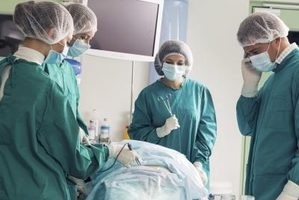Hospital Work Hazards

Those who work in hospitals are exposed to many hazards. By the very nature of a hospital, this is inevitable; hospital workers are constantly being exposed to patients with all kinds of infections. Apart from this, hospital workers are exposed to other types of hazards.
Viruses, Bacteria and Pathogens, Oh My
Biological hazards are those hazards caused by infectious agents such as viruses, fungi, parasites or bacteria, which may be contracted through contact with contaminated objects like syringes or scalpels, or through contact with infected patients. Diseases such as hepatitis B (HBV) hepatitis C, cytomegalovirus and human immunodeficiency syndrome virus (HIV), are transmitted through direct contact with infected blood and body fluids on broken, inflamed or chapped skin and the inside of the eye. Salmonella, shigella and campylobacter can be contracted by improper contact with fecal matter. Pulmonary tuberculosis, chicken pox and varicella zoster virus (VZV) can be contracted through inhalation of airborne droplets while herpes simplex virus (HSV) Type I and Type II can be contracted through saliva.
More Than a Sunburn
Physical hazards for hospital workers include ionizing and non-ionizing radiation. Ionizing radiation is the type of radiation used in such diagnostic procedures as fluoroscopy, x-ray, angiography and in treatments involving the use of radioactive injections or implantations. The long-term effects of exposure to ionizing radiation include genetic damage and negative effects on reproductive health. Non-ionizing radiation includes radiation from lasers. The intensity of the light beam from lasers is especially risky to the eyes and skin.
Aches and Pains
Ergonomics involves the application of science to the design of environments, tools and workstations to fit the mental and physical limitations and abilities. This includes such hazards as slippery floors, cluttered hallways, sharp utensils and the handling of materials. One of the most common injuries in the hospital is musculoskeletal injury, especially of the lower back, from handling and lifting heavy patients and objects. The application of ergonomic strategies can help alleviate this problem.
Clean But Harmful
Many chemicals used in the hospital can be toxic or harmful to the human body. Hospital cleaners are routinely exposed to cleaning and sterilizing agents; laboratory cleaners are exposed to tissue fixatives and reagents; nurses are exposed to disinfectants, solvents, and anti-cancer agents. Operating room staff are routinely exposed to anesthetic agents, while physicians are exposed to anti-cancer agents and disinfectants.
Violence
The Occupational Safety and Health Administration defines workplace violence as “violent acts (including physical assaults and threats of assaults) directed toward persons at work or on duty.” It states that research has shown that hospital workers are at a high risk for workplace violence, which often occurs during periods of high activity and interaction with patients. Such attacks are likely to occur when a service is denied or when a patient is admitted involuntarily.
Viruses, Bacteria and Pathogens, Oh My
Biological hazards are those hazards caused by infectious agents such as viruses, fungi, parasites or bacteria, which may be contracted through contact with contaminated objects like syringes or scalpels, or through contact with infected patients. Diseases such as hepatitis B (HBV) hepatitis C, cytomegalovirus and human immunodeficiency syndrome virus (HIV), are transmitted through direct contact with infected blood and body fluids on broken, inflamed or chapped skin and the inside of the eye. Salmonella, shigella and campylobacter can be contracted by improper contact with fecal matter. Pulmonary tuberculosis, chicken pox and varicella zoster virus (VZV) can be contracted through inhalation of airborne droplets while herpes simplex virus (HSV) Type I and Type II can be contracted through saliva.
More Than a Sunburn
Physical hazards for hospital workers include ionizing and non-ionizing radiation. Ionizing radiation is the type of radiation used in such diagnostic procedures as fluoroscopy, x-ray, angiography and in treatments involving the use of radioactive injections or implantations. The long-term effects of exposure to ionizing radiation include genetic damage and negative effects on reproductive health. Non-ionizing radiation includes radiation from lasers. The intensity of the light beam from lasers is especially risky to the eyes and skin.
Aches and Pains
Ergonomics involves the application of science to the design of environments, tools and workstations to fit the mental and physical limitations and abilities. This includes such hazards as slippery floors, cluttered hallways, sharp utensils and the handling of materials. One of the most common injuries in the hospital is musculoskeletal injury, especially of the lower back, from handling and lifting heavy patients and objects. The application of ergonomic strategies can help alleviate this problem.
Clean But Harmful
Many chemicals used in the hospital can be toxic or harmful to the human body. Hospital cleaners are routinely exposed to cleaning and sterilizing agents; laboratory cleaners are exposed to tissue fixatives and reagents; nurses are exposed to disinfectants, solvents, and anti-cancer agents. Operating room staff are routinely exposed to anesthetic agents, while physicians are exposed to anti-cancer agents and disinfectants.
Violence
The Occupational Safety and Health Administration defines workplace violence as “violent acts (including physical assaults and threats of assaults) directed toward persons at work or on duty.” It states that research has shown that hospital workers are at a high risk for workplace violence, which often occurs during periods of high activity and interaction with patients. Such attacks are likely to occur when a service is denied or when a patient is admitted involuntarily.
- kmf5158aec4a330e7f3439bf5d407e9390.jpg